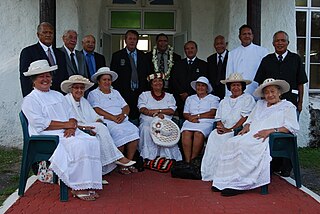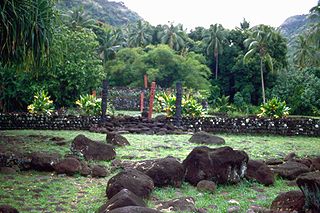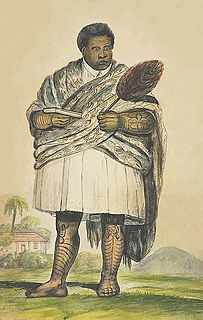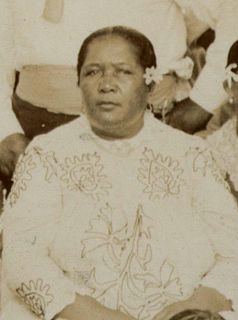Related Research Articles

The Cook Islands are named after Captain James Cook, who visited the islands in 1773 and 1777, although Spanish navigator Alvaro de Mendaña was the first European to reach the islands in 1595. The Cook Islands became a British protectorate in 1888.
Tapu is a Polynesian traditional concept denoting something holy or sacred, with "spiritual restriction" or "implied prohibition"; it involves rules and prohibitions. The English word taboo derives from this later meaning and dates from Captain James Cook's visit to Tonga in 1777.

The coat of arms of the Cook Islands has a shield as its focal point. The shield is blue with fifteen white stars arranged in a circle, as found on the national flag, and is supported by a flying fish (maroro) and a white tern (kakaia). The helmet is an ariki head-dress of red feathers, symbolising the importance of the traditional rank system, and the name of the nation is on a scroll below the shield. The achievement is augmented by a cross and a Rarotongan club used by orators during traditional discourses, respectively symbolizing Christianity and the richness of Cook Islands' tradition, placed in saltire behind the shield.

A marae, malaʻe, meʻae or malae is a communal or sacred place that serves religious and social purposes in Polynesian societies. In all these languages, the term also means cleared and free of weeds or trees. Marae generally consist of an area of cleared land roughly rectangular, bordered with stones or wooden posts perhaps with paepae (terraces) which were traditionally used for ceremonial purposes; and in some cases, a central stone ahu or a'u. In the Rapa Nui culture of Easter Island, the term ahu has become a synonym for the whole marae complex.

Samoans or Samoan people are the indigenous Polynesian people of the Samoan Islands, an archipelago in Polynesia, who speak the Samoan language. The group's home islands are politically and geographically divided between the Independent State of Samoa and American Samoa, an unincorporated territory of the United States of America. Though divided by national border, the culture and language are the same.
The culture of Fiji is a tapestry of native Fijian, Indian, European, Chinese, and other nationalities. Culture polity traditions, language, food costume, belief system, architecture, arts, craft, music, dance, and sports will be discussed in this article to give you an indication of Fiji's indigenous community but also the various communities which make up Fiji as a modern culture and living. The indigenous culture is an active and living part of everyday life for the majority of the population.
A tribal chief or chieftain is the leader of a tribal society or chiefdom.

Easter Island was traditionally ruled by a monarchy, with a king as its leader.
Fijian tradition and ceremony is a living way of life that has remained intact for millennia, evolving as the Fijian nation has modernised over time, with various external influences from Pacific neighbours, and European and Asian society. The term Fijian in this article refers to "indigenous Fijians" or "I Taukei" as the term Fijian generally includes all citizens of Fiji. This article is a general overview of various aspects of Fijian tradition, social structure and ceremony, much of it from the Bauan Fijian tradition. There are variations from province to province. Many social intricacies depend on one's inherited social position and the occasion one is confronted with: each will have a particular social etiquette. The Fijian terms in this article are most often of the Bauan dialect.

The House of Ariki is a parliamentary body in the Cook Islands. It is composed of Cook Islands high chiefs (ariki), appointed by the Queen's Representative. There are up to twenty-four members, representing different islands of the Cooks.
An ariki, ꞌariki, aliki, ali‘i, ari'i, aiki or hakaiki, akariki or ‘eiki (Tonga) is or was a member of a hereditary chiefly or noble rank in Polynesia.
A Tapere or Sub-District is a low level of traditional land subdivision on five of the Lower Cook Islands, comparable to the ahupua'a of the main Hawaiian Islands. Among the populated raised islands, only Mitiaro is not subdivided into tapere. The remaining southern Cook Islands, Manuae, Palmerston and Takutea are atolls and/or uninhabited, and therefore not subject to this type of traditional subdivision. The atolls of the northern Cook Islands are subdivided into motu, instead.

The Arioi or Areoi were a secret religious order of the Society Islands, particularly the island of Tahiti, with a hierarchical structure, esoteric salvation doctrine and cultish and cultural functions. They included both men and women of all social strata, though men predominated. The Arioi principally venerated the war god 'Oro, whom they considered the founder of their order.
A rangatira was the title given to a minor chief in the Cook Islands - often someone who was closely related to an ariki or mataiapo, now usually by the younger brothers or sisters; the head of a branch of a rangatira or mataiapo family.

Makea Pori Ariki was a sovereign of the Cook Islands. He was the ariki of the Makea Nui dynasty, one of the three chiefdoms of the Te Au O Tonga tribe on the island of Rarotonga.

Coronations in Oceania are, or were, held in the following countries:

Tinomana Mereana Ariki was a sovereign of the Cook Islands. She was the ariki of the Tinomana dynasty, a chiefdom of the Puaikura tribe on the island of Rarotonga. She was the second ariki of importance and position next to Makea Takau.
Monsang tribe are one among the indigenous tribes of North-East India, inhabiting the south-east part of Manipur state border to Myanmar particularly in Chandel district. Monsangs have their own distinct culture and tradition and are traditionally peaceful.

The culture of the Cook Islands reflects the traditions of its fifteen islands as a Polynesian island country, spread over 1,800,000 square kilometres (690,000 sq mi) in the South Pacific Ocean. It is in free association with New Zealand. Its traditions are based on the influences of those who settled the islands over several centuries. Polynesian people from Tahiti settled in the Cook Islands in the 6th century. The Portuguese captain, Pedro Fernandes de Queirós, made the first recorded European landing in the islands in the early 17th century, and well over a hundred years later, in the 18th century, the British navigator, Captain James Cook arrived, giving the islands their current name. Missionaries developed a written language, bringing schools and Christianity to the Cook Islands in the early 19th century. Cook Islands Māori, also known as Māori Kūki 'Āirani or Rarotongan, is the country's official language.
References
- ↑ Buse, Jasper (1995). Cook Islands Maori Dictionary. Cook Islands Ministry of Education. p. 235. ISBN 072860230X.
- ↑ Gilson, Richard Phillip (1980). The Cook Islands: 1820 - 1950. Victoria University of Wellington. ISBN 0705507351.
- ↑ Siikala, Jukka (1990). Culture and history in the Pacific. Finnish Anthropological Society. p. 117. ISBN 9519543589.
- ↑ Crocombe, R. G. (1964). Land Tenure in the Cook Islands. Oxford University Press. p. 227. ASIN B0000CMH60.